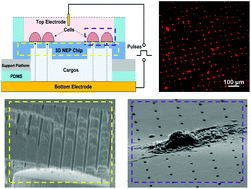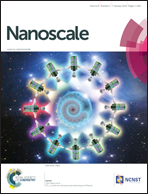3D nanochannel electroporation for high-throughput cell transfection with high uniformity and dosage control†
Abstract
Of great interest to modern medicine and biomedical research is the ability to inject individual target cells with the desired genes or drug molecules. Some advances in cell electroporation allow for high throughput, high cell viability, or excellent dosage control, yet no platform is available for the combination of all three. In an effort to solve this problem, here we show a “3D nano-channel electroporation (NEP) chip” on a silicon platform designed to meet these three criteria. This NEP chip can simultaneously deliver the desired molecules into 40 000 cells per cm2 on the top surface of the device. Each 650 nm pore aligns to a cell and can be used to deliver extremely small biological elements to very large plasmids (>10 kbp). When compared to conventional bulk electroporation (BEP), the NEP chip shows a 20 fold improvement in dosage control and uniformity, while still maintaining high cell viability (>90%) even in cells such as cardiac cells which are characteristically difficult to transfect. This high-throughput 3D NEP system provides an innovative and medically valuable platform with uniform and reliable cellular transfection, allowing for a steady supply of healthy, engineered cells.

- This article is part of the themed collections: Editor’s Choice: Making sense of nanosensors and devices and 2016 Nanoscale HOT Article Collection

 Please wait while we load your content...
Please wait while we load your content...